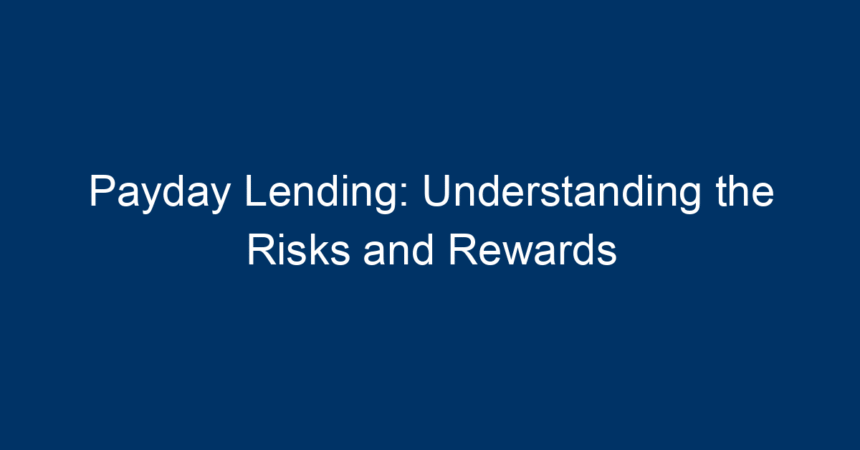In today’s fast-paced world, financial emergencies can arise when we least expect them. For many, payday lending emerges as a potential lifeline, offering quick access to cash for pressing needs. However, while the immediate relief may seem appealing, payday loans come with their own set of risks and rewards. In this article, we will delve into the intricacies of payday lending, helping you understand when it might be a viable option and when it might be best avoided.
What is Payday Lending?
Payday lending refers to short-term, high-interest loans typically intended to cover expenses until your next paycheck. Borrowers can often obtain these loans quickly—sometimes within just a few hours—without rigorous credit checks. This ease of access can be enticing, especially for those facing unexpected expenses, such as medical bills or car repairs.
How Does Payday Lending Work?
- Application Process: Borrowers usually complete a simple application, often online.
- Loan Approval: Upon approval, the lender will provide a cash advance, which typically does not exceed a few hundred dollars.
- Repayment Terms: Borrowers typically agree to repay the loan, plus interest, by their next payday.
These loans are often marketed as a quick solution to an immediate financial need. However, the underlying mechanics warrant a closer look.
The Appeal of Payday Lending
Quick Access to Cash
One of the most significant advantages of payday lending is the speed at which funds are made available. Traditional bank loans can take days or even weeks to process, while payday loans can often be approved within minutes.
Minimal Eligibility Requirements
Payday lenders tend to have fewer eligibility requirements compared to traditional lenders. Most require basic identification, proof of income, and a checking account. This accessibility can be particularly beneficial for individuals with poor credit histories, providing them a chance to secure the funds they need.
No Long-Term Debt
Unlike credit cards or personal loans that can lead to prolonged debt periods, payday loans are short-term. Borrowers repay the amount quickly, leading many to perceive it as a more manageable financial solution—on the surface.
The Risks of Payday Lending
High-Interest Rates
Payday loans often come with exorbitant interest rates, sometimes exceeding 400% APR. For example, if a borrower takes out a $500 loan with a fee of $75, they’ll need to repay $575 by their next payday. This heavy burden can trap borrowers in a cycle of debt, leading them to take out new loans to pay off old ones.
Short Repayment Terms
The short repayment terms associated with payday loans can contribute to financial distress. Borrowers may find themselves unprepared to repay the loan by their next paycheck, forcing them to incur more obligations. This cycle can lead to increased stress and larger financial problems.
Risk of Overdraft Fees
Borrowing more than you can afford can also lead to overdraft fees from your bank. If a borrower takes out a payday loan but does not have enough funds in their account to cover the repayment, they may incur additional financial penalties, exacerbating their situation.
Lack of Regulation
While some states have implemented regulations governing payday lending practices, others have not. This lack of oversight can lead to predatory lending practices, where borrowers are faced with unfair terms and fees.
Alternatives to Payday Lending
Considering the risks, it may be wise to explore alternative options for short-term financial needs. Here are some alternatives:
Credit Unions
Many credit unions offer small, low-interest loans with more flexible terms than payday lenders. If you’re a member of a credit union, inquire about their short-term loan options.
Structured Payment Plans
Consider reaching out to creditors or service providers to negotiate a payment plan. Many institutions would rather work with you directly than risk losing payment altogether.
Side Jobs and Part-Time Work
If possible, consider taking on a temporary side job or gig work to bridge the financial gap. This can provide additional income without the high costs associated with payday lending.
Emergency Savings Fund
Establishing an emergency savings fund may not be an immediate solution, but it is a long-term preventive measure. Aim to save at least three to six months’ worth of expenses to cushion against future emergencies.
Signs You Should Avoid Payday Lending
Identifying when payday lending may not be the right choice is just as crucial as knowing its advantages. Here are signs that you should steer clear:
-
Chronic Financial Instability: If you’re consistently struggling to make ends meet, payday loans may create further financial strain.
-
Unable to Repay Loans: If you have previously taken out payday loans and are unable to repay them, consider avoiding further loans.
-
Limited Financial Literacy: If you do not fully understand the implications of taking out a payday loan, it may be beneficial to seek advice before proceeding.
- Compounding Debt: If taking a payday loan means you will need to borrow more to cover existing loans, it may be time to reconsider your financial strategy.
Concluding Thoughts: Making Informed Decisions
Payday lending can offer immediate financial relief for emergencies, but it is essential for potential borrowers to understand both the risks and rewards. Weigh the pros and cons critically and consider alternatives before deciding.
If you find yourself in a position where payday lending seems to be your only option, it’s crucial to read the terms carefully, ensuring you fully understand the fees and repayment structure. Consulting with a financial advisor can provide valuable insights and guidance tailored to your specific situation.
Always remember, financial health is not solely about managing short-term crises; it also includes planning for the future. Avoid pitfalls by educating yourself and making informed choices. Understanding the landscape of payday lending empowers you to navigate your financial journey more effectively, ensuring that you are more resilient in the face of unexpected challenges.




